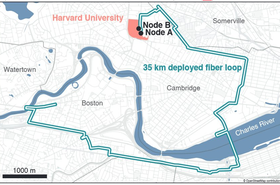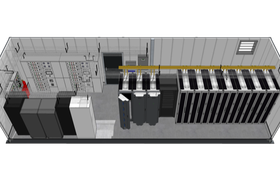Dedicated data center maintenance is critical in achieving tier classification via operational availability.
Holistic Data Center Infrastructure Monitoring (DCIM) has evolved and adopted widely by the different types of data center architectures: hyperscalers, multi-tenant colocation, telco, and lights-out design.
While CRAC, UPS, PDU, etc. already have the integrated capability for continuous monitoring; today, the passive busway infrastructure lacks the means for automated monitoring and yet it must deliver critical power to White (Data Halls) and Gray Spaces (Infrastructure).
Data center designers select the most appropriate product for lifecycle-design of a data center for White and Gray Space assets, DCIM has been a driver for automated surveillance and monitoring for automatic alerting to data center operators.
Nevertheless, traditional labor-intensive thermal imaging has been an industry practice for busway monitoring. Permanently installed thermal monitoring systems provide early detection of hotspots or potential issues and provide real-time alerts of all monitored locations including those not easily accessible during normal operation.
One version of DFOS technology that offers significant benefits for the data center is temperature monitoring. Distributed Temperature Sensing (DTS) provide real-time, 24/7/365 temperature monitoring across multiple assets within a data center using a single, passive fiber optic cable deployed as the temperature sensor.
Whenever heat is a concern, especially when monitoring busways, a passive fiber optic cable is fitted to the length of the busway housing. DTS technology can also be accompanied by asset visualization and data management software. Switchgear, HVAC, fire protection, BESS, and commercial power assurance are all areas where DTS integrates with DCIM.
The Advantages of DFOS Technology
- 100 percent continuous monitoring: real-time temperature information and alerts delivered to data center operation centers using thousands of temperature values measured along the asset.
- A long-established, intrinsic sensor technology that is used for monitoring mission-critical infrastructures and has the usual EMI/EMC and CE product certifications
- Rapid, real-time identification of hotspots or potential faults alerts available to facility maintenance teams via the operational center or by handheld devices. DFOS systems can identify a hotspot down to a resolution of 1m.
- As a new or retrofitted solution, DFOS uses an easy-to-install, passive, 4 mm diameter sensor cable that can be deployed for all assets requiring temperature monitoring. Once installed, the sensor cable requires virtually no maintenance.
- DFOS system are scalable for hyperscale, Colo, telco, and for lights-out data center. This allows data center facility maintenance to realize the infrastructure monitoring capabilities of the appropriate design tier level.
- Easy integration with other monitoring systems by standard Modicon Modbus communication protocol.
Reduced & simplified O&M effort with DFOS
Continuous Bus Temperature Monitoring (CBTM) for busways, bus ducts, and bus bars provides 24/7 measurement, alarming, reporting, and recording of the busway temperature along the entire length of the busway.
Continuous Switchgear Temperature Monitoring (CSTM) provides a simple, effective solution for monitoring all switchgear with a single DFOS system, enabling automated, remote, and 24/7 monitoring to all compartments and assets within switchgears.
Continuous Generator and Transformer Monitoring (CGTM) – by default, traditional high power-density, and critical assets are monitored to prevent unscheduled downtimes, high repair costs, and loss of revenue without risking asset failure which would result in severe damage to critical power facilities.
Continuous Rack Temperature Monitoring (CRTM) provides early detection and identification of hotspots and disruptive conditions as a result of overheating or thermal runaway.
HVAC assets, storage, and drainage benefit from 24/7 temperature monitoring, and sewage and drainage may also be continuously monitored for early leak detection in order to prevent outages, pinpoint hotspots, and ensure environmental compliance and operational efficiency.
Distributed Acoustic Sensing (DAS) technology can be used for Third Party Interference (TPI) detection, classifying, and location intrusion events including damages and theft along critical data center infrastructure.
Summary
DFOS technology provides real-time, holistic, and scalable monitoring capabilities for data center infrastructure providers and operators, which leads to the realization of cost savings and increased efficiency in maintaining critical and complex data center infrastructure by pinpointing the exact location of temperature abnormalities and alerting maintenance teams automatically.
DFOS technology is currently being used to monitor a variety of data center infrastructure assets including busways, switchgear, generators, transformers, renewable and storage energies, IT/battery racks, water storage and drainage, HVAC assets, and perimeters.








